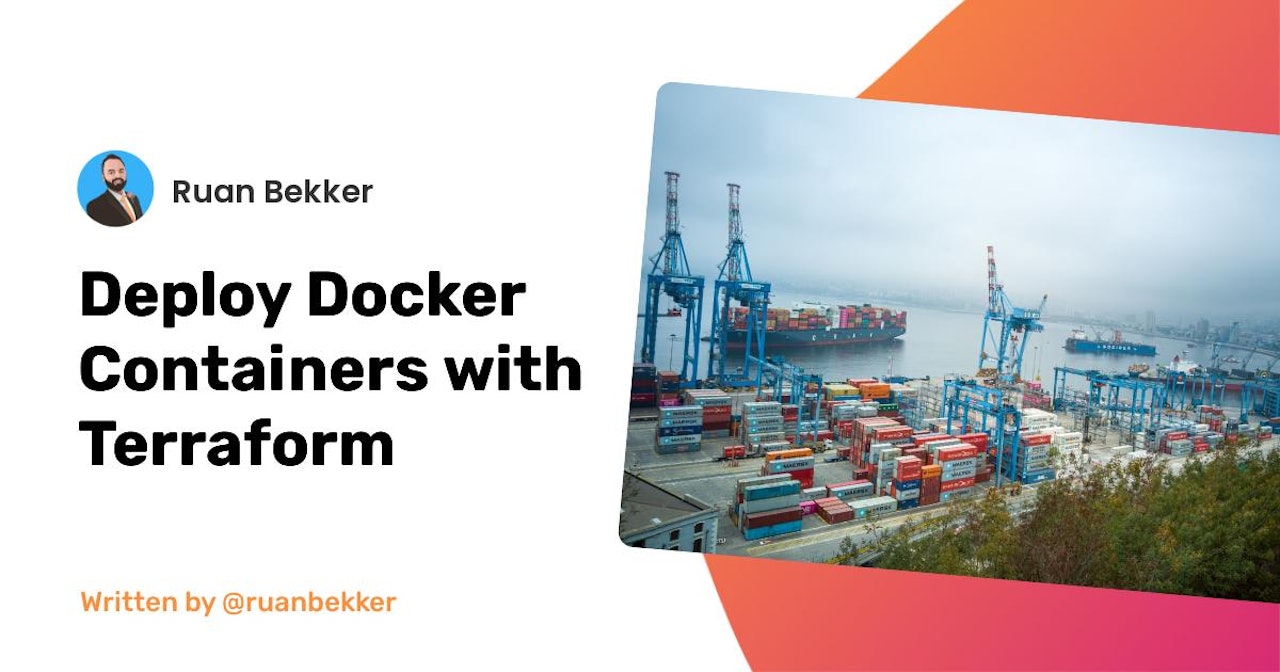In this post I will demonstrate how to use the terraform docker_container resource from the docker provider to run two docker containers, traefik and nginx and use the random provider to generate a random url for us.
Pre-Requisites
You will require terraform and docker to be installed.
Project Structure
The source code for this post is available on my github repository, but the project structure will look like the following:

Our providers.tf:
terraform {
required_providers {
docker = {
source = "kreuzwerker/docker"
version = "2.15.0"
}
random = {
version = "~> 3.0"
}
}
}
provider "docker" {
host = "unix:///var/run/docker.sock"
}
provider "random" {}
Our variables.tf:
variable "domain" {
type = string
default = "localdns.xyz"
}
Our outputs.tf:
output "nginx_container_name" {
value = docker_container.nginx.name
}
output "traefik_container_name" {
value = docker_container.traefik.name
}
output "traefik_url" {
value = "http://traefik.${var.domain}/"
}
output "nginx_url" {
value = "http://www.${random_string.nginx.result}.${var.domain}/"
}
Our main.tf:
resource "random_string" "nginx" {
length = 8
upper = false
special = false
}
resource "docker_image" "nginx" {
name = "nginx:stable-alpine"
}
resource "docker_image" "traefik" {
name = "traefik:1.7.14"
}
resource "docker_network" "nginx" {
name = "docknet"
driver = "bridge"
}
resource "docker_container" "traefik" {
name = "traefik"
image = docker_image.traefik.name
networks_advanced {
name = docker_network.nginx.name
aliases = ["docknet"]
}
restart = "unless-stopped"
destroy_grace_seconds = 30
must_run = true
memory = 256
volumes {
host_path = "/var/run/docker.sock"
container_path = "/var/run/docker.sock"
}
command = [
"--api",
"--docker",
"--docker.watch",
"--entrypoints=Name:http Address::80",
"--logLevel=INFO"
]
ports {
internal = 80
external = 80
ip = "0.0.0.0"
}
labels {
label = "traefik.enable"
value = true
}
labels {
label = "traefik.docker.network"
value = "docknet"
}
labels {
label = "traefik.frontend.rule"
value = "Host:traefik.${var.domain}"
}
labels {
label = "traefik.port"
value = 8080
}
}
resource "docker_container" "nginx" {
name = "nginx"
image = docker_image.nginx.name
networks_advanced {
name = docker_network.nginx.name
aliases = ["docknet"]
}
restart = "unless-stopped"
destroy_grace_seconds = 30
must_run = true
memory = 256
volumes {
host_path = "/Users/ruan/personal/terraform-playground/docker-containers/html"
container_path = "/usr/share/nginx/html"
}
volumes {
host_path = "/Users/ruan/personal/terraform-playground/docker-containers/configs/nginx.conf"
container_path = "/etc/nginx/nginx.conf"
}
volumes {
host_path = "/Users/ruan/personal/terraform-playground/docker-containers/configs/app.conf"
container_path = "/etc/nginx/conf.d/app.conf"
}
env = [
"PUID=501",
"PGID=20"
]
labels {
label = "traefik.enable"
value = true
}
labels {
label = "traefik.docker.network"
value = "docknet"
}
labels {
label = "traefik.frontend.rule"
value = "Host:www.${random_string.nginx.result}.${var.domain}"
}
labels {
label = "traefik.port"
value = 80
}
depends_on = [
docker_container.traefik,
random_string.nginx
]
}
Our html/index.html:
 View Website
View Website
 View Website
View Website
 View Website
View Website
<!doctype html>
<html lang="en">
<head>
<meta charset="utf-8">
<meta name="viewport" content="width=device-width, initial-scale=1">
<title>Welcome</title>
<!-- Fonts -->
<link href="https://fonts.googleapis.com/css?family=Nunito:200,600" rel="stylesheet">
<!-- Styles -->
<style>
html, body {
background-color: #fff;
color: #636b6f;
font-family: 'Nunito', sans-serif;
font-weight: 200;
height: 100vh;
margin: 0;
}
.full-height {
height: 100vh;
}
.flex-center {
align-items: center;
display: flex;
justify-content: center;
}
.position-ref {
position: relative;
}
.top-right {
position: absolute;
right: 10px;
top: 18px;
}
.content {
text-align: center;
}
.title {
font-size: 84px;
}
.links > a {
color: #636b6f;
padding: 0 25px;
font-size: 13px;
font-weight: 600;
letter-spacing: .1rem;
text-decoration: none;
text-transform: uppercase;
}
.m-b-md {
margin-bottom: 30px;
}
</style>
</head>
<body>
<div class="flex-center position-ref full-height">
<div class="content">
<div class="title m-b-md">
Welcome
</div>
<div class="links">
<a href="https://ruan.dev" target="_blank">About Me</a>
</div>
</div>
</div>
</body>
</html>
Our configs/nginx.conf:
user nginx;
worker_processes auto;
error_log /var/log/nginx/error.log notice;
pid /var/run/nginx.pid;
events {
worker_connections 1024;
}
http {
include /etc/nginx/mime.types;
default_type application/octet-stream;
log_format main '$remote_addr - $remote_user [$time_local] "$request" '
'$status $body_bytes_sent "$http_referer" '
'"$http_user_agent" "$http_x_forwarded_for"';
access_log /var/log/nginx/access.log main;
sendfile on;
keepalive_timeout 65;
include /etc/nginx/conf.d/app.conf;
}
And lastly, our configs/app.conf:
server {
listen 80;
server_name _;
location / {
root /usr/share/nginx/html;
index index.html;
}
location /healthz {
return 200 'up';
}
}
Deployment
Once everything is in place, or if you want to clone my repository, you can do that by:
git clone https://github.com/ruanbekker/terraform-docker-container-example
cd terraform-docker-container-example
Then we can initialize terraform by fetching the required plugins:
terraform init
Once that completes we can run a plan:
terraform plan
And that should output something more or less like:
Terraform used the selected providers to generate the following execution plan. Resource actions are indicated with
the following symbols:
+ create
Terraform will perform the following actions:
# docker_container.nginx will be created
+ resource "docker_container" "nginx" {
+ attach = false
+ bridge = (known after apply)
+ command = (known after apply)
+ container_logs = (known after apply)
+ destroy_grace_seconds = 30
+ entrypoint = (known after apply)
+ env = [
+ "PGID=20",
+ "PUID=501",
]
+ exit_code = (known after apply)
+ gateway = (known after apply)
+ hostname = (known after apply)
+ id = (known after apply)
+ image = "nginx:stable-alpine"
+ init = (known after apply)
+ ip_address = (known after apply)
+ ip_prefix_length = (known after apply)
+ ipc_mode = (known after apply)
+ log_driver = "json-file"
+ logs = false
+ memory = 256
+ must_run = true
+ name = "nginx"
+ network_data = (known after apply)
+ read_only = false
+ remove_volumes = true
+ restart = "unless-stopped"
+ rm = false
+ security_opts = (known after apply)
+ shm_size = (known after apply)
+ start = true
+ stdin_open = false
+ tty = false
+ healthcheck {
+ interval = (known after apply)
+ retries = (known after apply)
+ start_period = (known after apply)
+ test = (known after apply)
+ timeout = (known after apply)
}
+ labels {
+ label = "traefik.docker.network"
+ value = "docknet"
}
+ labels {
+ label = "traefik.enable"
+ value = "true"
}
+ labels {
+ label = "traefik.frontend.rule"
+ value = (known after apply)
}
+ labels {
+ label = "traefik.port"
+ value = "80"
}
+ networks_advanced {
+ aliases = [
+ "docknet",
]
+ name = "docknet"
}
+ volumes {
+ container_path = "/etc/nginx/conf.d/app.conf"
+ host_path = "/Users/ruan/personal/terraform-playground/docker-containers/configs/app.conf"
}
+ volumes {
+ container_path = "/etc/nginx/nginx.conf"
+ host_path = "/Users/ruan/personal/terraform-playground/docker-containers/configs/nginx.conf"
}
+ volumes {
+ container_path = "/usr/share/nginx/html"
+ host_path = "/Users/ruan/personal/terraform-playground/docker-containers/html"
}
}
# docker_container.traefik will be created
+ resource "docker_container" "traefik" {
+ attach = false
+ bridge = (known after apply)
+ command = [
+ "--api",
+ "--docker",
+ "--docker.watch",
+ "--entrypoints=Name:http Address::80",
+ "--logLevel=INFO",
]
+ container_logs = (known after apply)
+ destroy_grace_seconds = 30
+ entrypoint = (known after apply)
+ env = (known after apply)
+ exit_code = (known after apply)
+ gateway = (known after apply)
+ hostname = (known after apply)
+ id = (known after apply)
+ image = "traefik:1.7.14"
+ init = (known after apply)
+ ip_address = (known after apply)
+ ip_prefix_length = (known after apply)
+ ipc_mode = (known after apply)
+ log_driver = "json-file"
+ logs = false
+ memory = 256
+ must_run = true
+ name = "traefik"
+ network_data = (known after apply)
+ read_only = false
+ remove_volumes = true
+ restart = "unless-stopped"
+ rm = false
+ security_opts = (known after apply)
+ shm_size = (known after apply)
+ start = true
+ stdin_open = false
+ tty = false
+ healthcheck {
+ interval = (known after apply)
+ retries = (known after apply)
+ start_period = (known after apply)
+ test = (known after apply)
+ timeout = (known after apply)
}
+ labels {
+ label = "traefik.docker.network"
+ value = "docknet"
}
+ labels {
+ label = "traefik.enable"
+ value = "true"
}
+ labels {
+ label = "traefik.frontend.rule"
+ value = "Host:traefik.localdns.xyz"
}
+ labels {
+ label = "traefik.port"
+ value = "8080"
}
+ networks_advanced {
+ aliases = [
+ "docknet",
]
+ name = "docknet"
}
+ ports {
+ external = 80
+ internal = 80
+ ip = "0.0.0.0"
+ protocol = "tcp"
}
+ volumes {
+ container_path = "/var/run/docker.sock"
+ host_path = "/var/run/docker.sock"
}
}
# docker_image.nginx will be created
+ resource "docker_image" "nginx" {
+ id = (known after apply)
+ latest = (known after apply)
+ name = "nginx:stable-alpine"
+ output = (known after apply)
+ repo_digest = (known after apply)
}
# docker_image.traefik will be created
+ resource "docker_image" "traefik" {
+ id = (known after apply)
+ latest = (known after apply)
+ name = "traefik:1.7.14"
+ output = (known after apply)
+ repo_digest = (known after apply)
}
# docker_network.nginx will be created
+ resource "docker_network" "nginx" {
+ driver = "bridge"
+ id = (known after apply)
+ internal = (known after apply)
+ ipam_driver = "default"
+ name = "docknet"
+ options = (known after apply)
+ scope = (known after apply)
+ ipam_config {
+ aux_address = (known after apply)
+ gateway = (known after apply)
+ ip_range = (known after apply)
+ subnet = (known after apply)
}
}
# random_string.nginx will be created
+ resource "random_string" "nginx" {
+ id = (known after apply)
+ length = 8
+ lower = true
+ min_lower = 0
+ min_numeric = 0
+ min_special = 0
+ min_upper = 0
+ number = true
+ result = (known after apply)
+ special = false
+ upper = false
}
Plan: 6 to add, 0 to change, 0 to destroy.
Changes to Outputs:
+ nginx_container_name = "nginx"
+ nginx_url = (known after apply)
+ traefik_container_name = "traefik"
+ traefik_url = "http://traefik.localdns.xyz/"
Which we can see will create 2 containers, traefik and then nginx, map the configs and html in place and also sets the traefik hostname in the labels for our respective containers so that we can reach them via the specific host headers.
The we can deploy our containers:
terraform apply -auto-approve
Which will provide us the output detail defined from our outputs.tf:
Apply complete! Resources: 6 added, 0 changed, 0 destroyed.
Outputs:
nginx_container_name = "nginx"
nginx_url = "http://www.5igjdfq9.localdns.xyz/"
traefik_container_name = "traefik"
traefik_url = "http://traefik.localdns.xyz/"
Access our Containers
We can access our Traefik Dashboard on http://traefik.localdns.xyz and should look something like this:

And when we access our Nginx container on http://www.5igjdfq9.localdns.xyz it should look more or less like this:

Running a docker ps will show our running containers:
docker ps
CONTAINER ID IMAGE COMMAND CREATED STATUS PORTS NAMES
e45158ae8cba nginx:stable-alpine "/docker-entrypoint 3 minutes ago Up 3 minutes 80/tcp nginx
ebdbe42a0fcb traefik:1.7.14 "/traefik --api 3 minutes ago Up 3 minutes 0.0.0.0:80->80/tcp traefik
Cleanup
We can delete our containers by running:
terraform destroy -auto-approve
Thank You
Thanks for reading, if you like my content, check out my website or follow me at @ruanbekker on Twitter.


Comments (0)